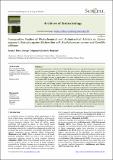| dc.description.abstract | Carica papayaextracts are known for their traditional medicinal uses. The ability of its parts to control the growth of common pathogens in the laboratory has been tested in different parts of the world using different varieties of C. papaya. This study was initiatedto compare the phytochemical and antimicrobial activity of different plant parts extracts of C. papaya var. papayi GAV4 on Escherichia coli, Staphylococcus aureusand Candida albicans. C. papayaplant parts were collected from a farm in Kiboswa (Kisumu): coordinates 0.0245°S and 34.7474°E, and then were transported to Maseno University Botany Laboratory. Seeds, green leaves and bark were washed thoroughly with tap water, rinsed in sterile water and dried after which they were ground using a grinder. From each of the three plant parts, three types of extracts were prepared using water, acetone and ethanol in the concentrations 25%, 50%, 75% and 100%. The antimicrobial activity of the extracts was tested on microbes growing on agar plates by inoculation with the different concentrations using diffusion method and replicated 3 times. Extracts were isolated using Soxhlet apparatus and MIC determined by serial dilution, zone of inhibition was measured in millimeters. Means from the measurements were separated andcompared at significance level P = 0.05. Phytochemicals present included alkaloids, flavonoids, tannins, phenols, saponins, glycosides, anthocyanins and terpenoids while anthraquinones were absent. Ethanol bark extract on C. albicansshowed higher inhibition and there were significant differences in inhibition among the plant parts and extracts used. In concentrations used, 25% was significantly different from 50%, 75% and 100%. The results obtained in this study confirm that C. papaya has antimicrobial activity on E. coli, S. aureusand C. albicans; and has also shown high potentials for use as a potential source of antibiotics to treat diseases caused by these microorganisms. | en_US |

